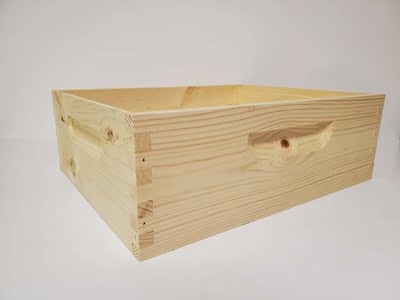

· By admin
Some Thoughts on Medium Hives
As you get started in beekeeping, there are many choices to make. Options like nucs vs packages, breed of bees, and hive sizes can cause unnecessary stress for the aspiring beekeeper, because usually there is no right or wrong answer. It comes down to what personally works for you.
Choosing your size and type of hive equipment is one such decision. A big question is 8 frame vs 10 frame, and we provide some thoughts on that in a separate article found here. Another option becoming more popular is a hive comprised entirely of medium depth boxes, which we'll call the "medium hive", and can be used in both 8 or 10 frame widths. This article explains some benefits and disadvantages of the medium hive.
First, let's explain deep vs medium boxes for those who don't know yet.
- A "deep" box, also known as a hive body, or deep super, is 9-5/8" deep. Deep boxes are commonly used for the brood area of the hive, where the queen lays eggs, and the bees store pollen and honey for their own use.
- A "medium" box, also called a super, medium super, midwestern super, or Illinois super, is 6-5/8" deep. It is most commonly used for storage of honey that will be removed by the beekeeper, due to the lighter weight of the box, which of course makes it much easier to handle. Some beekeepers choose to use the medium size box for all of their boxes, and we outline some pros and cons of that system below:
One more thing I want to explain is how a traditional hive is typically set up, in case you are confused about why we're explaining medium hives. A typical hive setup is one or two deep boxes on the bottom of the hive, which function as the brood nest. This is the area where the queen lays eggs, and the bees store up pollen and honey which are left on the hive year-around for the bees. Then, additional deep or medium boxes are placed above, and that is where the bees store honey that is removed by the beekeeper.
Pros of medium hives
- Weight - One of the main reasons people choose medium hives is because of the lighter weight. A deep box filled with honey typically weighs about 90-100 pounds, while a medium box is only 50-60 pounds.
- Interchangeability - Wow, that's a big word! The second (and probably the biggest) reason beekeepers love medium hives is because all the boxes and frames are the same size. This is really nice because you can easily exchange resources like brood, honey, and pollen between hives without any concern for the size of frames, which can be an issue for beekeepers who use both deep and medium boxes.
Cons of medium hives
- More frames and boxes - a medium box is roughly 30% smaller than a deep. So, in order to have the same amount of brood and honey area in the hive, you'll need more boxes and frames with medium hives vs deeps. This adds some expense (although not huge), but also means you have more boxes and frames to handle. As mentioned above, a "traditional" hive often consists of 2 deep boxes for the bees year-around habitat. A medium hive would require 3 boxes to provide about the same amount of space. This means you'll have additional boxes to move around as you inspect your hive, and makes it more difficult to find the queen because you have more frames to check.
- Nuc availability - for beekeepers who prefer to purchase a "nuc" for their starter bees instead of package bees, it can be harder to find nucs available in the medium-frame size. Nucs are most commonly made from deep frames. However, as medium hives increase in popularity, bee breeders are starting to make up nucs in the medium size.
Again, this isn't a decision you should stress too much over. No matter what hive configuration you choose, none of them will make much difference to the bees. It's about your own needs and preferences!
